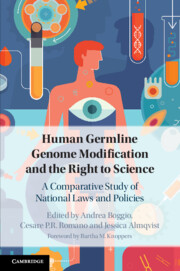 Human Germline Genome Modification and the Right to Science
Human Germline Genome Modification and the Right to Science from Part III - Asia
Published online by Cambridge University Press: 15 November 2019
Japan is a leader in life science, and is one of the countries in the world where reproductive medicine is actively practised. This chapter first analyses the overall regulatory framework for research using human germ cells and embryos (germline). Then, it discusses the specific regulations affecting research on human germline genome modification, while considering the clinical research of an egg mitochondrial DNA modifying technique, called AUGMENT. Regarding research involving human germline genome modification, the Japanese regulatory framework is characterized by gaps and inconsistencies. Moreover, it discusses some of the reasons why Japan lacks a key law governing the medical use of human germline, although the Act on Regulation of Human Cloning Techniques is put into force. It points out that a majority of Japanese is not affiliated with religion, and ‘Morals’ is a vague concept in Japanese. Finally, it discusses a possible regulatory reform, considering four provisions relevant to human rights in the Constitution of Japan.
To save this book to your Kindle, first ensure no-reply@cambridge.org is added to your Approved Personal Document E-mail List under your Personal Document Settings on the Manage Your Content and Devices page of your Amazon account. Then enter the ‘name’ part of your Kindle email address below. Find out more about saving to your Kindle.
Note you can select to save to either the @free.kindle.com or @kindle.com variations. ‘@free.kindle.com’ emails are free but can only be saved to your device when it is connected to wi-fi. ‘@kindle.com’ emails can be delivered even when you are not connected to wi-fi, but note that service fees apply.
Find out more about the Kindle Personal Document Service.
To save content items to your account, please confirm that you agree to abide by our usage policies. If this is the first time you use this feature, you will be asked to authorise Cambridge Core to connect with your account. Find out more about saving content to Dropbox.
To save content items to your account, please confirm that you agree to abide by our usage policies. If this is the first time you use this feature, you will be asked to authorise Cambridge Core to connect with your account. Find out more about saving content to Google Drive.